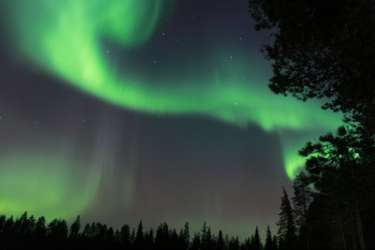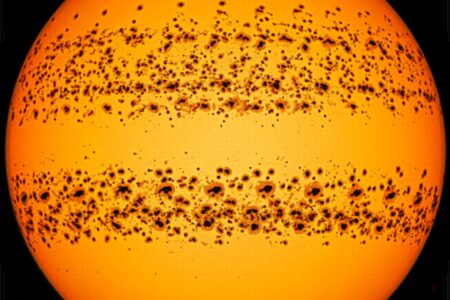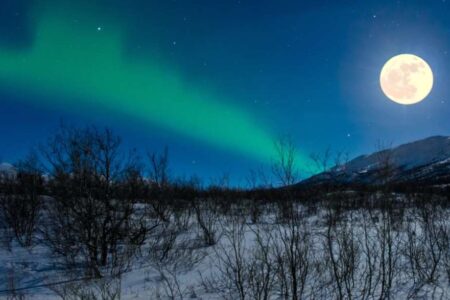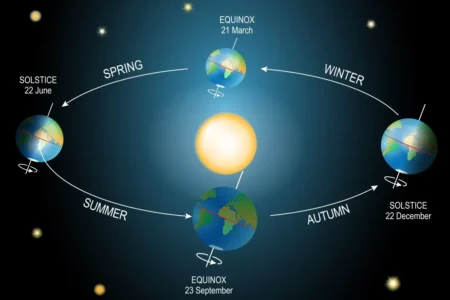Imagine standing beneath the vast Arctic sky as ribbons of colourful light shimmer above. Seeing the Northern Lights is a breath-taking experience — one that stays with you forever.
But to have the best chances of seeing the aurora borealis at its most dazzling, timing is everything. And the best time to see the northern lights is from September to early April.
During this time, each new season offers something unique. From the fiery hues of autumn to the deep polar darkness of winter to the crisp, bright days of spring.
So when should you plan your visit? Here, we break down the best locations and activities for an unforgettable northern lights holiday, whether you plan to travel in autumn, winter or spring.

The Northern Lights in autumn (September to November)
Why plan an autumn aurora holiday?
Autumn is a magical time to see the northern lights. This season marks the return of the aurora after a summer of midnight sun.
During this time, the Arctic landscape glows with golden autumn colours and night skies are at their darkest. And with lakes yet to freeze over, you may even catch the stunning sight of the northern lights mirrored in still waters.
Travelling in autumn is easy. No deep snow, no icy roads. Just crisp autumn air and opportunities for hiking, kayaking and — in Iceland and Norway — whale watching.
Where to see the northern lights in autumn
Iceland. Autumn arrives in Iceland later than on the mainland. So lush green landscapes in September slowly shift to deep oranges and reds from October onwards. And — because you can snowmobile on glaciers here — you don’t have to wait for the snow to arrive to enjoy winter activities.
Norway. This is the peak season for whale watching in Norway. Mountaintops are dusted with snow. And Norway’s fjords reflect the northern lights, which makes for exceptional photographs.
Sweden and Finland. The northern region of Sweden and Finland — known as Lapland — is renowned for its beautiful autumnal colours. This is a great time to explore the Arctic wilderness on guided hiking and foraging trips.
What to expect
Longer nights. After long summer days, the nights are drawing in. In northern Europe, the sun sets at around 7:30 pm each night, which means there’s a good window of darkness in which to see the aurora.
Dark nights. Autumn nights aren’t as long as those of midwinter. But they’re particularly dark because there’s no snow to reflect light back into the sky. This makes for excellent aurora viewing.
The autumn equinox. The autumn equinox falls during September. During the equinox, the angle of the Earth in relation to the sun increases the number of solar particles entering Earth’s atmosphere. This can lead to vibrant aurora displays.
Milder temperatures. From September up to early October, temperatures are mild and the weather is stable. This means less cloud cover to obscure the aurora. In November, the weather becomes a little more unpredictable, so you may have to travel further to find clear skies.
Easy travel conditions. Because snow is yet to fall, travelling around the Arctic is easy. And this is a perfect time for fly-drive holidays in Iceland.
The northern lights in autumn: at a glance
Top activities:
- Whale watching
- Kayaking
- Hiking
- Foraging
- Glacier snowmobiling
Hours of daylight:
- Tromsø in northern Norway: 9 hours
- Reykjavik in Iceland: around 10 hours
- Abisko in Swedish Lapland: around 9.5 hours
- Rovaniemi in Finnish Lapland: around 9.5 hours
Temperature:
- Tromsø in northern Norway: -2 to 11 ˚C
- Reykjavik in Iceland: 0 to 11 ˚C
- Abisko in Swedish Lapland: -10 to 11 ˚C
- Rovaniemi in Finnish Lapland: -7 to 11 ˚C
Weather conditions:
Generally settled throughout September and October. In November, as snow begins to fall, there are more storms and cloudy nights.
Find your once-in-a-lifetime northern lights trip
Let the travel experts at Aurora Nights create a tailored northern lights trip based on your choice of destinations, accommodation and activities.
Browse our northern lights holidays to Finland, Sweden, Norway and Iceland.
The northern lights in winter (December to February)
Why plan a winter northern lights holiday?
From December onwards, the winter aurora season kicks off in earnest. Hours of darkness increase and the landscape is transformed into a winter wonderland, with snow-laden trees, frozen waterfalls and icy Arctic tundra to explore.
This is the season for winter activities, like husky sledding, snowmobiling and snowshoe excursions. And for warming up by the log fire — or in a hot tub under the stars — at the end of another exciting day.
Where to see the northern lights in winter
Iceland. During winter, an aurora guide can take you to see Iceland’s glaciers, where localised weather patterns mean more clear nights and some of the best northern lights sightings. You can also embark on self-drive tours in southern Iceland but roads in northern Iceland are sometimes subject to closures at this time of year.
Norway. Norway remains warmer during winter thanks to the Gulf Stream. Its fjords don’t freeze so you can sail through crystal clear waters on an aurora cruise. You can also enjoy plenty of fun in the snow, with an extensive range of winter activities on offer.
Sweden. In Sweden, Abisko and the frozen seas of the Luleå archipelago have a unique microclimate, meaning more clear nights and exceptional aurora viewing conditions. And the incredible Ice Hotel opens in December — why not pop in for cocktail hour?
Finland. If a trip to see Santa is on your wishlist, make your way to Rovaniemi or Saariselkä. Finland is also renowned for its glass igloo and log cabin accommodation, perfect for a memorable winter escape.
What to expect
Cold temperatures in Sweden and Finland. In Lapland, temperatures regularly drop as low as -17˚C. Warm Arctic outerwear and snow boots are essential at this time of year and are included in our northern lights holiday packages.
Slightly milder temperatures in Iceland and Norway. Iceland and coastal Norway are warmer than Lapland. Temperatures regularly drop below freezing but don’t reach the lows of northern Sweden and Finland.
Long, dark nights. During winter, daylight hours drop dramatically, maximising your chances of seeing the aurora. In the northernmost parts of Europe, the sun disappears for the best part of a month. You’re also treated to skies lit with beautiful peach-pink tones as the sun nears the horizon each day.
Exciting winter activities. Think husky sledding and reindeer sleigh rides. Ice caving and snowshoeing. You can even climb a frozen waterfall for an unforgettable Arctic experience.
Christmas and New Year trips. Snowy landscapes make Christmas and New Year celebrations even more magical. Take the family to see Santa and his elves. Or ring in the New Year, watching spectacular fireworks as you sail Reykjavik harbour.
The northern lights in winter: at a glance
Top activities:
- Snowmobiling
- Husky sledding
- Ice caving
- Reindeer sleigh rides
- Visits to see Santa Claus
Hours of daylight:
- Tromsø in northern Norway: none between the end of November and mid-January
- Reykjavik in Iceland: around four to six hours
- Abisko in Swedish Lapland: none between early December and early January
- Rovaniemi in Finnish Lapland: around two to three hours
Temperature:
- Tromsø in northern Norway: -6 to 1 ˚C
- Reykjavik in Iceland: -2 to 3 ˚C
- Abisko in Swedish Lapland: -17 to -5 ˚C
- Rovaniemi in Finnish Lapland: -14 to -5 ˚C
Weather conditions:
Cold and snowy, with some cloudy nights in December. February is often the coldest month of the year. Bear in mind that the temperatures listed above are averages and it can feel much colder with the wind chill.
The northern lights in spring (March to early April)
Why plan a spring northern lights holiday?
Spring is the peak of the northern lights season.
In March, northern Europe is still blanketed in snow, which means many winter activities are still on the menu. And — while days are longer — there are still plenty of hours in which to see the aurora each night.
Skies at this time of year tend to be clear. Plus, the equinox in March brings another surge of solar activity.
Where to see the northern lights in spring
All northern lights destinations in Europe remain excellent at this time of year. The Icelandic landscape starts to thaw at the end of March. But in northern Norway, Sweden and Finland the snow tends to hang around for longer, until mid-April. Sweden and Finland, in particular, are good for late-season husky sledding.
What to expect
More hours of daylight. The days are growing longer, which means fewer hours of darkness in which to see the aurora. But more hours in which to explore stunning Arctic landscapes. For many travellers, this aurora borealis season offers the best of both worlds — beautiful scenery by day and thrilling aurora excursions by night.
Snowy landscapes. The days may be getting longer but temperatures are still very cold at the start of March. Lakes and snowy landscapes won’t thaw until April so you still have plenty of time to enjoy winter activities like husky sledding and snowmobiling.
Warmer temperatures. The last week of March and the first week of April are sometimes sunny and warm — it’s not uncommon to see people wandering around in t-shirts! Clear skies are also common, which means the northern lights are often visible.
The spring equinox. Around the spring equinox (in March), the position of the Earth means bigger and brighter northern lights displays.
The northern lights in spring: at a glance
Top activities:
- Snowmobiling
- Husky sledding
- Ice fishing
- Snowshoeing
- Cross country skiing
Hours of daylight:
- Tromsø in northern Norway: 10 to 14 hours
- Reykjavik in Iceland: 10 to 13 hours
- Abisko in Swedish Lapland: 10 to 14 hours
- Rovaniemi in Finnish Lapland: 10 to 13 hours
Temperature:
- Tromsø in northern Norway: -4 to 1 ˚C
- Reykjavik in Iceland: -1 to 4 ˚C
- Abisko in Swedish Lapland: -11 to -2 ˚C
- Rovaniemi: -10 to -2 ˚C
Weather conditions:
In March, it’s still very cold but there are fewer cloudy nights than in winter. In April, snow and ice start to thaw.
The best season to see the northern lights?
Autumn, winter and spring all offer exceptional and unique northern lights holiday experiences. It really comes down to what you want your trip to look like.
A blaze of autumn colours? A winter wonderland? A spring landscape bursting into life?
Here at Aurora Nights, we create bespoke aurora holidays. So simply tell us what you’d like to do on your northern lights tour and we can recommend the best time of year to visit.
Pack your bags for an unforgettable aurora adventure
Let the Aurora Nights team create a bespoke aurora tour, just for you.
Aurora season FAQs
Can you see the northern lights in summer?
No, you can’t see the northern lights in summer.
In places where the northern lights are likely to be visible, summer days are long. In the far north of Europe, the sun doesn’t set at all for up to 76 days every year.
During daylight hours, the sky is too bright for us to see the aurora borealis. So the best time to see the northern lights is during autumn, winter or early spring when nights are longer.
What is the best aurora season?
The aurora season runs from September to early April. It covers autumn, winter and early spring. The autumn and spring equinoxes are a good time to visit and there are fewer cloudy nights in February and March.
When does the Iceland northern lights season start?
The aurora season in Iceland starts in September and lasts until early April. Self-drive tours are better in autumn. But it’s possible to see the aurora at any time during autumn, winter or spring.
When is the Norway aurora season?
The Norway northern lights season lasts from September to early April. From December onwards, you can enjoy winter activities like husky sledding and snowmobiling. February is the coldest month but you get lots of clear skies around this time of year.
When is the aurora borealis season in Sweden?
The aurora season in Sweden runs from September to early April. Nights are darkest in autumn, longest in winter and clearest in spring. And you can enjoy winter activities from December to March.
When is the northern lights season in Finland?
The Finland northern lights season starts in September and ends in early April. During this time, nights are long and dark, which means more hours in which to see the aurora.
During September and October, you can see beautiful autumn colours in Finland. From December through to March, you can enjoy winter activities like husky sledding and snowmobiling.










